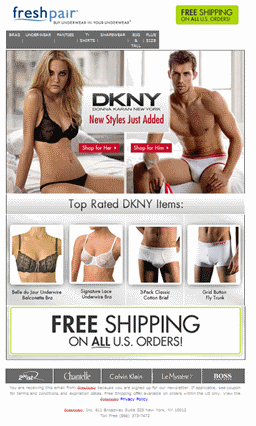Email Marketing: New tactics for display ads, segmentation and discount promos
I interviewed a variety of email marketers at Responsys Interact 2012 last week and learned about more tactics than I could ever fit into a blog post. That said, here are three insights I pulled from some of the best interviews I had last week (Full Disclosure: Responsys sponsored my attendance of this event).
Display will rise again
Now that companies can target display ads to individuals across a variety of websites, display is poised to make another comeback, says Scott Jones, General Manager of Display, Responsys.
The reason, Jones says, is that marketers can incorporate display into cross-channel and lifecycle marketing programs and use it to send a targeted message to a single person. He sees display ads improving results for email marketers in the following three ways:
1. Extend automated campaigns
Triggered emails can reach very specific, very engaged audiences and can have great conversion rates. Some companies are supporting their triggered campaigns by also showing display ads to the people who receive the emails.
“We’re seeing marketers take their existing automated programs and start to add display to extend their number of touches with those people, and they are meaningful, relevant, highly orchestrated touches.”
2. Engage inactive subscribers
If your team has high-value subscribers who have not opened an important marketing email, then you can use targeted ads to encourage them to visit a landing page that features the same campaign, Jones says.
For example, a clothing brand could give subscribers a sneak peak of an upcoming fall collection via email. Any subscribers who did not click the email can be shown targeted display ads to encourage them to view the fall collection, possibly with a discount offer.
3. Market to non-subscribers
It can seem like a lost opportunity when a paying customer does not opt-in for your emails. However, you can still reach that person with targeted, lifecycle messages, Jones says. Some marketing teams are using the same lifecycle approach they would use in email but instead are doing it through a combination of display ads and other channels to reach customers who have not subscribed.
Using the clothing brand example from above, Jones says a sequence of ads could feature:
- The upcoming fall collection
- The launch of the fall collection
- A discount offer for the fall collection
- An offer tied to telling three friends about the fall collection
“If they convert at any time, you can stop showing them the ads and drop them into a repeat buyer program, which has completely different messaging,” Jones says.
Segment later to capture more opt-ins
Marketers have a tough decision to make when signing up people for their email programs. How much information do you ask for? If you ask for too much, you can kill the conversion rate on the registration page. If you ask for too little, it can be difficult to segment your database.
The marketing team at Freshpair, an underwear and lingerie retailer, bypasses this challenge through “progressive profiling,” says Jason Scoggins, Senior Director of Email Marketing, Freshpair.
“We [tried] to keep the barrier to sign up as easy as possible. We only [captured] email address, and so until you’ve made a purchase and we can start targeting you on purchase behavior, we [had] nothing else,” he says.
That was true until the team launched this new series of welcome emails:
 Email #1. Capture product preference
Email #1. Capture product preference
New subscribers first receive an email that asks them to select which types of products they prefer, men’s or women’s. That email gives Freshpair a key datapoint for segmenting its list, Scoggins says.
Email #2. Reassure subscribers
The second email is delivered four days later and mostly emphasizes the value proposition surrounding Freshpair’s email program, Scoggins says. Emphasizing the value someone receives in the emails helps reassure them that they’ve made a good decision in signing up for the program, he says.
For example, the emails note that subscribers will receive:
- First notice of sales
- Product information and expert knowledge
- First notice of new products
Email #3. Discount offer
If subscribers have not yet purchased, they will receive the third and final welcome email three days after the second that offers them a discount.
Overall, the program has helped the team improve its segmentation without hurting the conversion rates on its registration forms, and the welcome series helps generate revenue, Scoggins says.
“We’ve definitely seen a strong lift. We’ve seen our welcome program have an increase of 27% in revenue per email.”
Cut the discount, not conversions
The marketing team at Nutrisystem, a weight-loss products and services provider, generates leads through its registration-based community and online tools. People who enter the database receive a welcome email that previously included a $50 discount offer, says Megan Parzych, Director of Marketing Communications, Nutrisystem.
Instead of offering new subscribers $50 off, the first email offered a $30 discount. Later emails in the series offered larger discounts, and any subscribers who purchased stopped receiving the emails.
After testing the change and launching full-scale, the team realized that response rates remained the same, and the amount of revenue lost to discounts had fallen dramatically, Parzych says.
“Our open rates, our click rates and our conversion rates — our key campaign KPIs — did not decrease by reducing the promotion,” she says.
Related Resources:
Email Marketing: Dollar Thrifty generates 47-times higher ROI, O’Neil doubles CTR
Email Marketing: How to overcome segmentation challenges and deliver targeted content
How to Nearly Double Conversions by Targeting Ads to Recent Visitors: 5 Steps
Categories: Email Marketing









